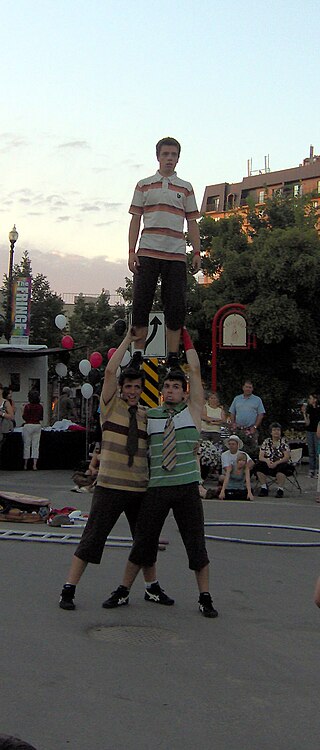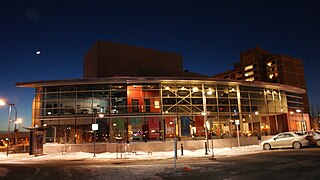Related Research Articles

The University of Saskatchewan is a Canadian public research university, founded on March 19, 1907, and located on the east side of the South Saskatchewan River in Saskatoon, Saskatchewan, Canada. An "Act to establish and incorporate a University for the Province of Saskatchewan" was passed by the provincial legislature in 1907. It established the provincial university on March 19, 1907 "for the purpose of providing facilities for higher education in all its branches and enabling all persons without regard to race, creed or religion to take the fullest advantage". The University of Saskatchewan is the largest education institution in the Canadian province of Saskatchewan. The University of Saskatchewan is one of Canada's top research universities and is a member of the U15 Group of Canadian Research Universities.
The Saskatchewan Railway Museum is a railway museum located west of Saskatoon, Saskatchewan at the intersection of the Pike Lake Highway and the Canadian National Railway tracks. It is operated by the Saskatchewan Railroad Historical Association (SRHA) and was opened in 1990.

The Saskatchewan Transportation Company (STC) was a Crown corporation in the Canadian province of Saskatchewan responsible for operating intercity bus routes in the province from 1946 to 2017. Created in 1946 by an Order in Council giving the company a mandate to provide service between major urban centres and to as much of the rural population as possible, STC was a wholly owned subsidiary of the Crown Investments Corporation of Saskatchewan.

The Saskatchewan Accelerator Laboratory (SAL) was a linear accelerator facility on the University of Saskatchewan campus in Saskatoon, Saskatchewan, Canada. The facility was constructed in 1962 at a cost of $1.7M under the direction of Leon Katz. SAL was identified by the OECD as a National Large-Scale Facility. SAL provided support for radiology, chemistry and sub-atomic physics research.

The Western Development Museum is a network of four museums in Saskatchewan, Canada preserving and recording the social and economic development of the province. The museum has branches in Moose Jaw, North Battleford, Saskatoon and Yorkton. Respectively, each branch focuses on a different theme: transportation, agriculture, economy, and people. The museum is affiliated with the Canadian Museums Association, the Canadian Heritage Information Network, and Virtual Museum of Canada.

Eastview is a mostly residential neighbourhood located in south-central Saskatoon, Saskatchewan, Canada. It is a suburban subdivision, consisting of low-density, single detached dwellings, low-rise apartment buildings and semi-detached houses. As of 2007, the area is home to 3,566 residents. The neighbourhood is considered a middle-income area, with an average family income of $58,703, an average dwelling value of $260,050 and a home ownership rate of 51.6%.

Greystone Heights is a mostly residential neighbourhood located in east-central Saskatoon, Saskatchewan, Canada. It is a suburban subdivision, consisting mostly of low-density, single detached dwellings and a sizeable minority of apartment-style multiple-unit dwellings. As of 2007, the area is home to 2,525 residents. The neighbourhood is considered a middle-income area, with an average family income of $58,811, an average dwelling value of $241,850 and a home ownership rate of 58.1%.
Joseph Stevens Jones was an American actor, playwright, theater manager, and surgeon. He wrote at least 150 plays that were mostly produced at theaters in Boston, Massachusetts.

The Saskatoon Fringe Festival produced by 25th Street Theatre is an annual Fringe theatre festival in Saskatoon, Saskatchewan, Canada. A Fringe Festival is not censored, and not juried, provides live theatre inexpensively, and a public busking forum for musicians. The 10-day international theatre, arts, and culture Festival is hosted annually in the Broadway District in the Nutana neighborhood.

Shakespeare on the Saskatchewan is a yearly summer Shakespeare theatre festival founded in 1985 in Saskatoon, Saskatchewan, Canada. In addition to productions of plays by William Shakespeare and his contemporaries, the festival's activities include medieval feasts, workshops, tours, art displays, special matinees, and a free community stage.

Rugby Chapel is a municipal historic site which is part of the University of Saskatchewan. The U of S is the largest education institution in the Canadian province of Saskatchewan. The University of Saskatchewan location next to the South Saskatchewan River was across from the city centre of Saskatoon. In 1879, the Rt. Rev. John McLean started a schooling system in Prince Albert which was renamed the University of Saskatchewan in 1883. In 1909, when the University of Saskatchewan was established in Saskatoon, Emmanuel College moved its college buildings to Saskatoon. The Institute for stained glass in Canada has documented the stained glass at Rugby Chapel.

Prairieland Park is an events centre on the south-central edge of Saskatoon, Saskatchewan. The park is located in the Exhibition neighbourhood of Saskatoon. Each year the park hosts an annual Saskatoon Exhibition variably called "The Ex". During the remainder of the year most of the park venues are rented out to special events. Some events held are Western Canadian Crop Production Show, Saskatchewan indemand trade show, Saskatoon Fall Fair cattle show and sale, Pet Expo, Chuckwagon Racing, and the Prairieland Junior Ag Showcase.

Broadway Avenue is an arterial road and commercial street in Saskatoon, Saskatchewan. It begins at the east end of the Broadway Bridge and continues south for about 4 kilometres until terminating at a cul-de-sac in the Avalon neighbourhood. The commercial portion, and the section usually referred to colloquially as "Broadway," is composed of the five blocks running south from the Broadway Bridge to 8th Street East, as well as the adjoining blocks east and west. This section makes up the Broadway Business Improvement District, and is a popular shopping and cultural destination of Saskatoon, featuring many restaurants and bars, boutique shops, local businesses, and annual street festivals, including the Saskatoon Fringe Theatre Festival.

Meacham is a village in the Canadian province of Saskatchewan within the Rural Municipality of Colonsay No. 342 and Census Division No. 11. It is located 69 kilometres east of the City of Saskatoon on Highway 2.
The Saskatoon Symphony Orchestra (SSO) is a professional orchestra based in Saskatoon, Saskatchewan, administered by the non-profit Saskatoon Symphony Society. The orchestra was founded in 1927 as an amateur orchestra, but today has 10 core members and up to 50 sessional musicians. Arthur Collingwood, who was Professor of Music at the University of Saskatchewan, presented the first SSO concert. The SSO received major funding from the Carnegie Institute in 1931. The Canada Council, the Saskatchewan Arts Board, and the City of Saskatoon have all provided sponsorship of the SSO through the years. In the spring, the symphony holds a Saskatoon Symphony Book & Music Sale to raise funds for the orchestra. The SSO itself offers students grants and hosted a national cello competition in 1990. Dwaine Nelson was responsible for the development of a full-time core of musicians, initially with a size of six, but later expanded to the present-day ten members. In the summer of 2014, the SSO announced that Maestro Victor Sawa would move into the position of Conductor Emeritus at the end of the 84th season. In March 2015, the SSO announced Eric Paetkau as the 16th Music Director of the orchestra.

The Pioneer Theatre Company (PTC) is one of four professional theatre companies in Utah, and the only fully professional theatre in Salt Lake City, contracting with union members belonging to Actors' Equity Association (AEA), Stage Directors and Choreographers Society (SDC) and United Scenic Artists (USA829). PTC was formed in 1962 and performs at the Simmons Pioneer Memorial Theatre on the University of Utah campus in Salt Lake City. The non-profit company produces seven plays each season, running from September to May, including classics, musicals, dramas, and comedies. The company creates its own productions on site, including costumes and scenery, while sometimes using actors and directors from out-of-state. Among a number of premieres, the company produced the nation's first regional premiere of Les Misérables in 2007, giving 82 sold out performances.

Frank & Ellen Remai Arts Centre is a performing arts centre in the River Landing area of Saskatoon, Saskatchewan, Canada. The centre is owned by and the main venue for the Persephone Theatre. Constructed in 2007 at a cost of $11 Million Canadian, the main theatre seats 450, with a second smaller 100-seat theatre and other supporting facilities and workshops that make up the centre.

The Adilman Building is a historic building in the Riversdale district of Saskatoon, Saskatchewan, Canada. It is one of Saskatoon's remaining examples of Streamline Moderne architecture.

When Emrys Jones was appointed professor of Drama at the University of Saskatchewan, in 1944, he is credited with being the first full professor of Drama at any University in the Commonwealth.
Susan Wright was an award-winning Canadian actress. Most prominently associated with stage roles, she also had a number of supporting roles in film and television.
References
- 1 2 3 Shelley A. Leedahl (2008-08-27). "Emry's Dream: Greystone Theatre in Photographs and Words". Sask books . Retrieved 2020-08-31.
Variety shows and choruses had been performed at the U of S since 1909, but when Emrys Jones, a journalist, director, actor and educator, took the Drama Department's helm in 1945, Greystone Theatre's curtains rose on a new era of superbly directed and acted live theatre, and that tradition of excellence continues to the present.
- ↑ "GREYSTONE THEATRE: JOHN MITCHELL BUILDING, 118 SCIENCE PLACE, SASKATOON, SK, S7N 5E2". Tourism Saskatoon . Retrieved 2020-08-31.
Whether classical or cutting-edge and contemporary, every season offers a diverse mix of plays chosen to challenge our students and to entrance our audiences: a matter that is as true today as it was in 1946, when Greystone Mainstage Productions premiered on campus at the U of S.